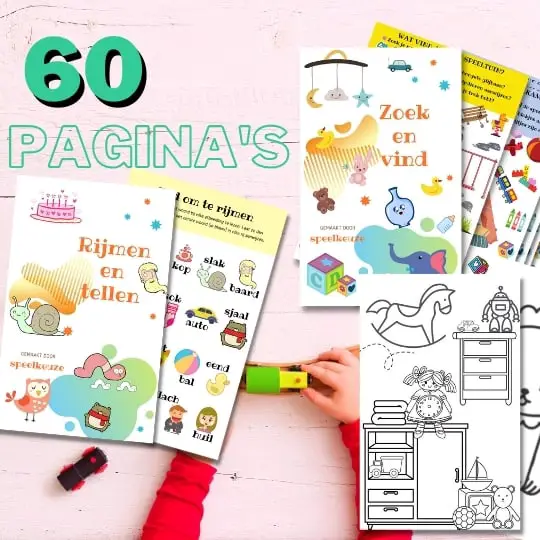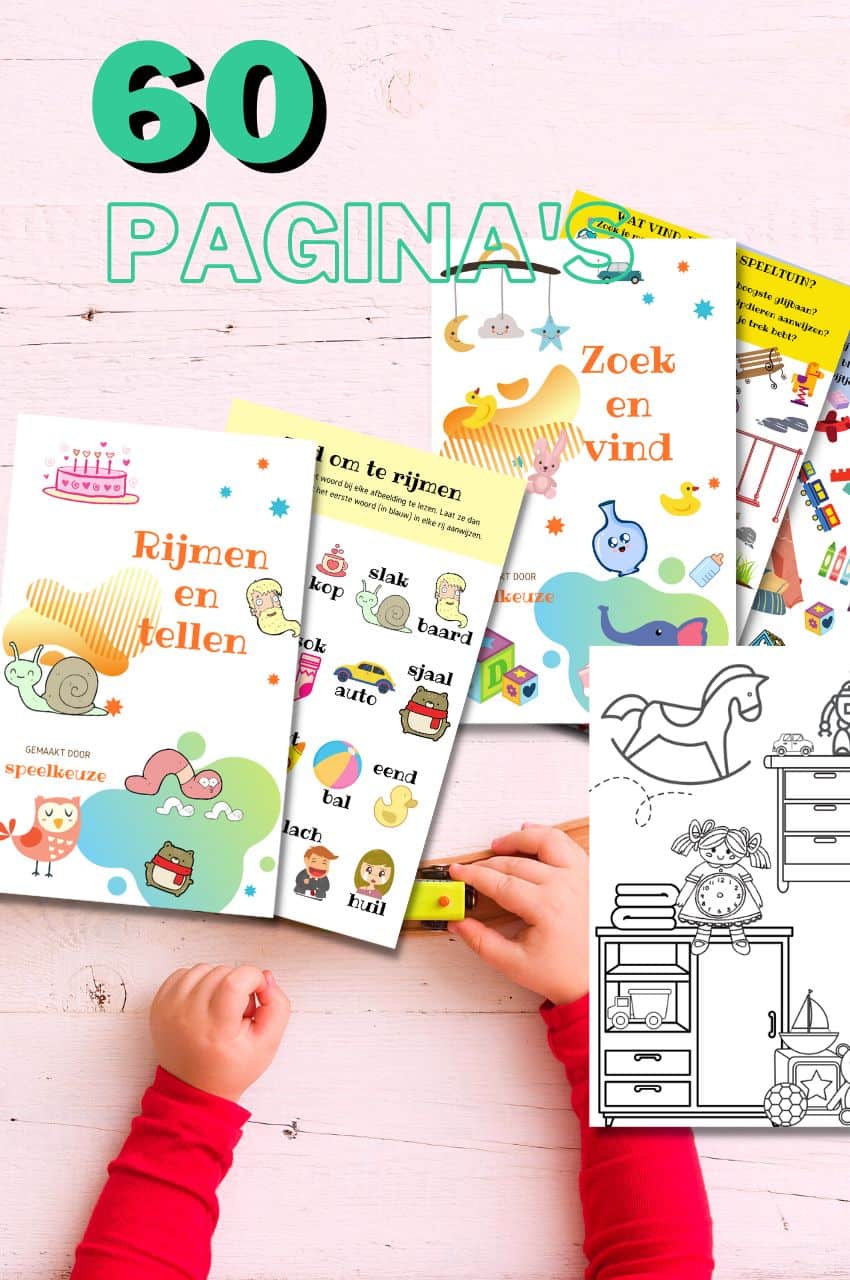STEM education for children: 5 reasons why

Always something to do for the holidays or rainy day?
Play Choice now has the ultimate activity book collection, with over 60 pages of fun coloring pages and educational puzzles.
What is STEM for children?
STEM stands for Science, Technology, Engineering and Mathematics. It is an approach to teaching science subjects in which children learn to solve problems and think creatively. STEM is a way to teach children about the world of science, technology, engineering and math.
In this article I will tell you all about STEM and how you can use it in children's education.


From toddler to toddler activity book collection
Educational games and coloring pages for 3 to 6 years
Your toddler and preschooler will love this e-book, along with the accompanying printables. He or she can play with it at every stage of development, together with mom and dad.
Buy at Bol.comWhat we discuss in this comprehensive post:
The four pillars of STEM: Science, Technology, Engineering and Mathematics
STEM (the perfect starter toy reviewed here) encompasses a broad category of skills and knowledge essential to economic development and the needs of the future.
In recent years there has been a huge change in the way we approach engineering and science, and STEM plays a major role in this.
There is a growing demand for technical and science professionals, and in many cases there is a shortage.
By introducing children to STEM at an early age, we help them prepare for a successful future in a rapidly changing world.
The skills children develop with STEM
STEM focuses on developing a number of important skills in children, including:
- Problem-solving thinking: Children learn to analyze problems and find solutions step by step.
- Creativity: They discover new ways to build and design things, and are encouraged to develop their own ideas.
- Collaboration: STEM activities are often group-based, where children learn to collaborate and communicate to achieve a common goal.
- Critical Thinking: Children learn to analyze information, make connections and make informed decisions.
VOTE in everyday life
STEM is not only important at school, but also at home. Children often enjoy experimenting with technology and engineering, and parents can encourage this enthusiasm by engaging in fun STEM activities with their children. Think, for example, of building a robot, designing an app or conducting a scientific experiment.
In addition, STEM also offers support for parents and teachers. For example, the EU has developed a comprehensive set of guidelines and tools to help schools and families integrate STEM into education and everyday activities.
The role of mathematics in STEM
Mathematics is one of the main pillars of STEM and is the foundation for many of the skills children develop. It helps children to think logically and structuredly, and is crucial for understanding complex concepts in science, technology and engineering. By familiarizing children with mathematics at an early age, we lay the foundation for their further development in the field of STEM.
In short, STEM is an essential part of children's education and development, and plays a vital role in preparing our youth for the challenges of the future. By encouraging children to learn and grow within the worlds of science, technology, engineering and math, we equip them with the skills they need to succeed in an ever-changing world.
The rise of STEM in formal primary education
Nowadays, STEM education has become an indispensable part of primary education. Our society is changing rapidly and we need more and more people who can actively think along and work on solutions for the challenges of the future. That is why it is important that we introduce our children to the world of science, technology, engineering and mathematics from an early age. In this way we ensure that children receive the right foundation from formal education to be successful later in their lives and careers.
Outdoor education and collaboration with artists
Outdoor education can make an important contribution to stimulating children's interest in STEM. By bringing children into contact with nature and the world around them, they learn about science and technology in a playful and discovering way. Collaborating with artists can also help introduce children to STEM in a creative way. For example, artists can teach workshops that teach children how to use technology and science to create art.
The pilot: STEM education on location
This pilot investigates the benefits of STEM education on location. We look at how this form of education can contribute to the knowledge transfer and development of children. The aim is to discover which methods work best to make children enthusiastic about STEM and how we can integrate this into regular education. Instagram plays no role in this, it is purely about the educational value of the activities and the impact on the children.
All in all, it is clear that STEM education plays an important role in the development of children and their preparation for the future. It is up to us, as a society and education sector, to ensure that we give our children the best possible start in science, technology, engineering and math.
The wonderful world of STEM: what children learn from it
STEM teaches children much more than just the basic principles of science, technology, engineering and mathematics. They develop a broad knowledge and skills that help them better understand how the world around them works. By asking questions and looking for answers, they learn to recognize and solve problems in a creative and innovative way.
Stimulating own thinking and problem solving skills
STEM activities encourage children to use their own thinking skills and come up with solutions to problems they encounter. They learn to think more deeply about the topics and to find practical solutions. This is important, as it helps them better cope with complex situations and challenges in the future.
Collaborate and learn in groups
Many STEM activities involve children working together in groups. This is great because it teaches them to communicate, collaborate and share ideas with others. They also learn to listen to the opinions of others and to think critically about their own ideas. This is an important skill that they can put to good use later in life, both professionally and personally.
Learning and experimenting through play
STEM isn't just serious and heavy; it can also be a lot of fun and playful! Children learn through play and experimentation with new ideas and concepts. They try things out, make mistakes and learn from them. This ensures that they are not afraid of failure and that they remain motivated to keep learning and discovering.
Involvement of parents and the community
Parents and the community play an important role in promoting STEM in children. From a young age, parents can help their children develop an interest in science, technology, engineering and math by playing games, reading books or doing activities related to these subjects. Schools and other community organizations can also help promote STEM by offering workshops, clubs and events.
In short, children learn a lot from STEM. They develop a broad knowledge and skills that help them to better understand the world around them and to solve problems in a creative and innovative way. They also learn to collaborate, communicate and think critically. And most importantly, they have a lot of fun with it!
VOICE: A world without borders for children
When I think back to when I learned about STEM, I remember how this learning method broke down the boundaries between different academic disciplines. Rather than approaching each field separately, STEM integrates them all into one cohesive and relevant way of learning. This creates a world in which science, technology, engineering and mathematics go hand in hand.
I remember a specific experiment where we had to solve a problem that had both chemistry and astronomical aspects. We had to use a combination of astrophysics and chemistry to come up with a solution. This approach ensured that we not only practiced enough with the different disciplines, but also understood how they are interrelated.
International recognition for STEM
STEM is not only a learning method used in the Netherlands, but has also gained international recognition. For example, there is the Danish Dion project, in which children learn in a playful and investigative way. This project is in line with the international vision on STEM and shows that this learning method produces more effective results worldwide.
The power of STEM therefore lies in breaking down the boundaries between professional fields and motivating children to learn in a playful and investigative way. This approach creates a world in which children are not only good at one specific field, but also understand where the different disciplines intersect and how they can work together to arrive at a solution.
STEM activities for the home
As a parent, you want your child to be actively involved in his or her learning process. A fascinating approach to this is the world of the 'maker'. Makers are creative people who like to build, design and invent things. They are always looking for new ideas and ways to improve their knowledge and skills. There are plenty of examples available to get started with STEM at home.
Learning through play with STEM experiments
A popular idea to get kids involved in STEM at home is through play. There are many fun and educational games that offer the basics of science, technology, engineering and math in a playful way. This way children can practice in a free and relaxed way with the right skills. An example of this are the experiments you can do at home, such as building a volcano or making a self-driving car.
Visit a science museum
Another way to make children enthusiastic about STEM is to visit a science museum together, such as NEMO in Amsterdam or the Experimentarium in Brussels. Here children can become acquainted with natural science, technology and mathematics in an interactive way. There are often workshops and experiments that anyone can participate in.
Make use of online resources
The internet is full of fun and educational STEM activities for kids. There are countless websites and YouTube channels where you can find inspiration for experiments, experiments and projects you can do at home. Find fun ideas with your child and get to work!
Create a makerspace at home
A makerspace is a place where children (and adults) can experiment, learn and create using technological equipment, such as 3D printers, laser printers and electronics. You can set up a small makerspace at home by creating a space where your child can freely experiment with different materials and tools. This way you stimulate your child's creativity and problem-solving ability.
Social media play an important role in the exchange of knowledge and ideas in the field of STEM. There are various online communities and groups where you as a parent or child can go for tips, advice and inspiration. For example, think of Facebook groups, Instagram accounts and Pinterest boards that are full of fun and educational STEM activities.
By paying attention to STEM at home, you prepare your child for a future in which science, technology, engineering and math are becoming increasingly important. In addition, you stimulate your child's curiosity, creativity and problem-solving ability. So what are you waiting for? Get started together with fun and challenging STEM activities!
VOTE or rather STEAM?
If you are already familiar with STEM, you may have heard of STEAM. But what exactly is the difference between these two terms? And why would you choose one or the other? Let's explore that!
STEAM stands for Science, Technology, Engineering, Arts and Mathematics. So it is basically the same as STEM, but with the addition of art (Arts). The idea behind STEAM is that art and creativity play an important role in solving complex problems and developing innovative ideas.
Why STEAM?
Adding art to STEM has a number of benefits:
- It stimulates creative thinking, which is essential for solving problems and coming up with new solutions.
- It helps children to gain a broader understanding of the world around them and the different fields that play a role in it.
- It encourages children to follow their passions and interests, even if they are not directly related to science, technology, engineering or math.
VOICE or STEAM: which is better?
There is no one-size-fits-all answer to this question, as it depends on the child's goals and interests. Both approaches have their own advantages:
- STEM focuses on developing skills and knowledge directly related to science, technology, engineering and mathematics. This can prepare children well for a future career in these fields.
- STEAM, on the other hand, offers a broader approach, integrating art and creativity into the learning experience. This can help children learn in a more holistic way and encourage them to discover their own unique talents and interests.
Conclusion
STEM is a wide variety of subjects that encompass science, technology, engineering, and math. It is important to introduce children to STEM at an early age to help them become a logical, creative and problem-solving person who understands the world around them.
If your child has shown an interest in STEM, it's important to encourage them to experiment, design and build. Let's hope this guide helped you with that.

Always something to do for the holidays or rainy day?
Play Choice now has the ultimate activity book collection, with over 60 pages of fun coloring pages and educational puzzles.
Joost Nusselder, the founder of Speelkeuze.nl is a content marketer, father and loves trying out new toys. As a child he came into contact with everything related to games when his mother started the Tinnen Soldaat in Ede. Now he and his team create helpful blog articles to help loyal readers with fun play ideas.
